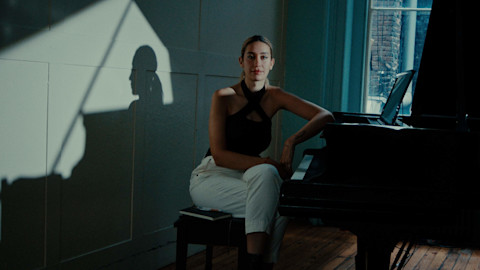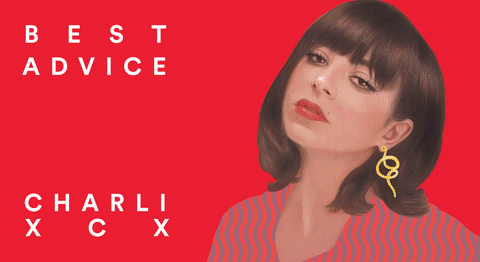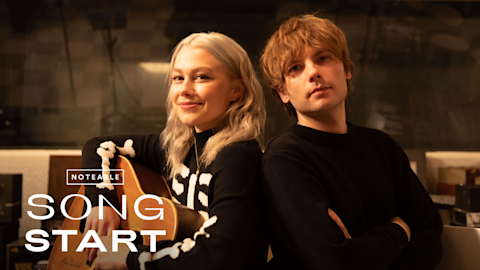The Norwegian bedroom-pop artist breaks down her setup.
Since releasing her first single, the propulsive, longing "i wanna be your girlfriend," in the spring of 2018, girl in red has become known for producing bedroom pop.. 20-year-old Marie Ulven began writing and recording songs in her bedroom in Horten, Norway, in late 2017, using the intimacy afforded by that space to get in touch with her feelings and play around with ideas of song structure.
"I don't really write with people," says Ulven, who recorded Norwegian music before turning to the girl in red project. "I haven't really done proper writing sessions yet, but I'm guessing that if you're not completely 100% comfortable with the people you're working with, you might not say that one line that you actually wanted to say because you were just like, 'That's weird.' Instead, I'm just like, 'Okay, I'll write down whatever because nobody's going to see this, nobody's going to hear this.' I can just work in my own space and be in control."
Ulven's setup has evolved somewhat since she started writing and playing as girl in red. She's mostly played Fender guitars since the beginning. "I used a Fender Stratocaster [when recording my earliest songs]," she writes. "I've gotten a few new ones, but I still mostly use Strats or [Fender] Telecasters."
USB-enabled interfaces allowed Ulven to record her earliest songs right into her computer. "When I first started recording in my room, I had an Apogee Jam interface. It has just one USB-to-guitar jack input, so I could play directly into my Mac. Then I had this Blue Yeti microphone that I had gotten for my birthday from my dad, and Apple earbuds. I had a 13-inch MacBook, 2013 model, and that had GarageBand. It was a very minimalist, very small setup, and I made 'i wanna be your girlfriend,' 'say anything,' and 'summer depression' on it."
When the holidays rolled around, Ulven's family helped her upgrade her setup slightly. "For Christmas," she notes, "I got a Røde microphone from my grandpa, and then I got a Scarlett interface from my mom and Logic from my mom. But it's still been really simple.
"I still have that same interface," she adds. "I bought a new computer, though—I had to do that because mine totally died. The projects I was making were too cool and my computer couldn't handle it," she laughs. "But otherwise, I pretty much have the same setup."
girl in red's latest single, the fuzzed-out anthem "i'll die anyway," was written and recorded on the same setup—although the surroundings are a bit more bustling. " I moved from a very, very small town that was boring and quiet to the capital of Norway, Oslo," she says. "I have the same bedroom studio, but it's in a different room." Ulven believes that the key to making the creative process flow easily is understanding the DAW (digital audio workstation) you're working with, whether it's one she's used like GarageBand and Logic or other offerings like Ableton or ProTools. "Having a music program that you understand and can work with, and not feel like it's working against you, is crucial for when you're starting out. You can have gear, but if you don't understand the programs, it's very not motivating at all. You need to have something that you feel comfortable with, and that you feel like you're actually getting something out of."
But, Ulven notes, you shouldn't expect to become an expert right away—and you should look toward challenging yourself, whether through mainlining online tutorials or taking a trial-and-error approach. "I'm still learning a lot," she says, "even though I'm a pretty slow learner. I've noticed that I'm keeping in my little safe bubble—if I know a way to do something, I'm not going to try to find another way. 'If it ain't broke, don't fix it.' But I feel like I should challenge myself more with production or else it's probably going to get boring for me. So learning more is a goal for the future."
She's also allowing people into her process, although so far it's been very deliberate; "i'll die anyway" was mixed by someone who she "trusted as a person" before they worked together. "I've mixed all of my songs, except 'dead girl in the pool.' But otherwise, I've done everything," she says. "I'm very, very careful with who I'm letting in to this project, and I've let someone work with me on the mixing now. I still produced it in my room, and I wrote it in my room, and I'm doing all the recording, doing all the writing. But someone else is in there and taking a bit more space in my production, which is scary."
-Maura Johnston
Popular Stories
video
How Julia Wolf Made It




